
 of movement
of the human body. Usually it is a series of rhythmical
movements of the feet and other body parts performed in time to music.
Dance movements, generally stylized,
can follow either prescribed or improvised steps and gestures.
Dance has its own aesthetic
and expressive potential.
It can be done for the pleasure of either an individual dancer
or a group of dancers, or of an audience.
Many of the primitive forms
of dance have a ritualistic or ceremonial purpose, often demanding
specific costumes, sometimes masks, and many have long-standing traditions. Some dancers achieve
certain mind-body states — sometimes mystical or spiritual ones.
Some dancers persue it as a kind of physical exercise.
of movement
of the human body. Usually it is a series of rhythmical
movements of the feet and other body parts performed in time to music.
Dance movements, generally stylized,
can follow either prescribed or improvised steps and gestures.
Dance has its own aesthetic
and expressive potential.
It can be done for the pleasure of either an individual dancer
or a group of dancers, or of an audience.
Many of the primitive forms
of dance have a ritualistic or ceremonial purpose, often demanding
specific costumes, sometimes masks, and many have long-standing traditions. Some dancers achieve
certain mind-body states — sometimes mystical or spiritual ones.
Some dancers persue it as a kind of physical exercise. 
![]()
 Types
of dance include folk, jig, waltz, flamenco, polka, ballet, modern,
foxtrot, jitterbug, tango, cha cha, rhumba, hula, tap, and breakdancing,
among many
others. Postmodern
dance can consist of the most ordinary movements — walking, sitting,
slouching, leaning over, etc. A dance can be an occasion for dancing.
Choreography is both the designing of
sequences of dance movements,
and the dance that results from it.
Types
of dance include folk, jig, waltz, flamenco, polka, ballet, modern,
foxtrot, jitterbug, tango, cha cha, rhumba, hula, tap, and breakdancing,
among many
others. Postmodern
dance can consist of the most ordinary movements — walking, sitting,
slouching, leaning over, etc. A dance can be an occasion for dancing.
Choreography is both the designing of
sequences of dance movements,
and the dance that results from it.
In Greek mythology, Terpsichore is the muse of choral song and dance.
Art about or made for dance:

Mycenaean, Group of Three Dancers in a Ring, c. 1300 BCE, terra cotta painted with slip, British Museum, London.
![]()
Etruscan, Antefix, terra
cotta, early 400s BCE, 21 7/16 x 12 3/4 x 6 1/2 inches (54.6 x 32.5 x 16.5
cm), J. Paul Getty Museum, Malibu, CA. A silenos
and maenad dance in a Dionysiac revel on this Etruscan antefix.
See mythology.

Chinese, Dancer-Shaped Pei Pendants, Western Han Dynasty (206 BCE - 25 CE), white jade, 4.6 x 2.5 cm, Henan Museum, China. Unearthed at Yongcheng, Henan. This pair of pei pendants is carved in openwork and engraved lines. Also see
Chinese art and Han.

Indian, Tamil Nadu, Shiva as Lord of Dance (Nataraja), Chola
period (880-1279), c. 11th century, copper
alloy, height
26 7/8 inches (68.3 cm), diameter
22 1/4 inches (56.5 cm), Metropolitan Museum of Art, NY. See
Shiva.
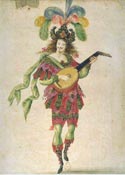
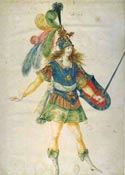

French, Lute Player, the Warrior, and Apollo, drawings
of costumes
for the Ballet royal de la nuit (Royal Ballet of the
Night), c. 1650, Bibliotheque Nationale France, Paris. The
ballet ends with the appearance of Aurore, who yields her place
to the rising sun -- Apollo --
played the premiere performance by the young King Louis XIV --
popularly known ever since as "The Sun King." See Baroque.
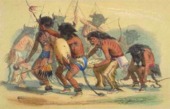
George Catlin (American, 1796-1872), The Buffalo Dance,
1848, chromolithograph,
from a set of prints: "Die Indianier Nord Amerikas",
published in Brussels, Belgium. Such prints were effectively
reproductions of paintings.
See American Indian art.

Jean-Baptiste Carpeaux, The Spirit of the Dance, 19th century, marble, height 41 1/4 inches (104.8 cm), North Carolina Art Museum, Raleigh.

Sri Lankan, The Serpent Demon, a Kolam dancer's mask, 19th century,
pre-1885, height 66 cm,
British Museum, London. Sri Lanka is the island once known as
Ceylon to the east of India. Kolam is a rural Sri Lankan form
of drama involving both mime, dialogue, and dance, by actors
who wear masks and costumes. The museum says, "The characters
are divided into several types: humans (for example, princes,
the drummer and his wife, the European), animals and demons,
and the performances move from the depiction of village scenes
to stories involving spirits and fabulous creatures from Hindu mythology. The Serpent Demon is a fierce
character representing the evil power of snake
poisons that can destroy human and animal life. The figure can be recognized partly by the presence
of the cobras coiling to form a crown
around its head and the snakes that emerge from its nostrils.
There are several species of poisonous snakes in Sri Lanka; the
cobra in particular is often depicted on demon masks that are
used by dancers in rituals to expel evil from the body of a patient."

Edgar Degas (French, 1834-1917), Grande Arabesque, c. 1885-90, posthumous
cast, bronze,
40.0 x 50.8 x 34.3 cm, Tate Gallery, London.
Jose Guadalupe Posada (Mexican, 1852-1913), Happy dance and wild party of all the skeletons (Gran fandango y francachela de todas las calaveras), no date, broadside, engraving on type metal. See Mexican art.
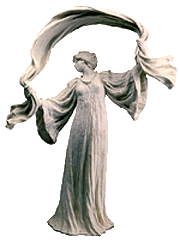
Agathon Léonard (French, 1841-1923)
for Sèvres, Royal Porcelain Factory, Dancing Figure from the Table Centrepiece 'Dance
with Scarves', 1900, bisque
porcelain, height 47.5 cm, Hermitage Museum,
St. Petersburg, Russia. This Art Nouveau figure is one of fourteen in a set of female
figures dancing and playing music.
See drapery.
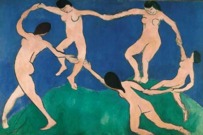
Henri Matisse
 (French, 1869-1954), Dance (first version), 1909, oil
on canvas, 8 feet
6 1/2 inches x 12 feet 9 1/2 inches (259.7 x 390.1 cm), Museum
of Modern Art, NY. Matisse painted a second version of
(French, 1869-1954), Dance (first version), 1909, oil
on canvas, 8 feet
6 1/2 inches x 12 feet 9 1/2 inches (259.7 x 390.1 cm), Museum
of Modern Art, NY. Matisse painted a second version of Dance in 1910, oil
on canvas, 102 x 154 inches
(260 x 391 cm), Hermitage Museum, St. Petersburg, Russia. Dance,
together with Music, was commissioned
by S.I.Shchukin to decorate
the staircase in his Moscow mansion.
Matisse took the motif
of the round dance, used as a symbol
back as far as French Renaissance,
![]() to represent the rhythm
and expression of the
20th century. The spaciousness and expressive lines
emphasize the dynamics
of the figures.
Simplified and schematic
forms intensify the brightness
and resonance of the
three colors -- red, blue and green. Dance, Matisse once said,
meant "life and rhythm." See circle, Fauvism,
music, and rhythm.
to represent the rhythm
and expression of the
20th century. The spaciousness and expressive lines
emphasize the dynamics
of the figures.
Simplified and schematic
forms intensify the brightness
and resonance of the
three colors -- red, blue and green. Dance, Matisse once said,
meant "life and rhythm." See circle, Fauvism,
music, and rhythm.
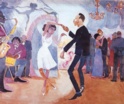
Palmer Hayden (American, 1890-1973), Jeunesse, no date, watercolor on paper, 14 x 17 inches, collection of Dr. Meredith F. Sirmans, NY. This and works by many other artists of the Harlem Renaissance were influenced by their enjoyment of jazz, an often improvisational musical form developed during the 1920s by African Americans and influenced by European harmonic structure and African rhythmic complexity. Jazz can be identified by its characteristic blues rhythms and distinctive speech intonations. Harlem has long been an important center for jazz. Palmer Hayden could have seen such dancing as this at the Savoy, Harlem's most famous jazz club.
Also see body art, finger paint, interdisciplinary, kinesthetic, performance art, permanence, puppet, and theater.
https://inform.quest/_art
Copyright © 1996-![]()